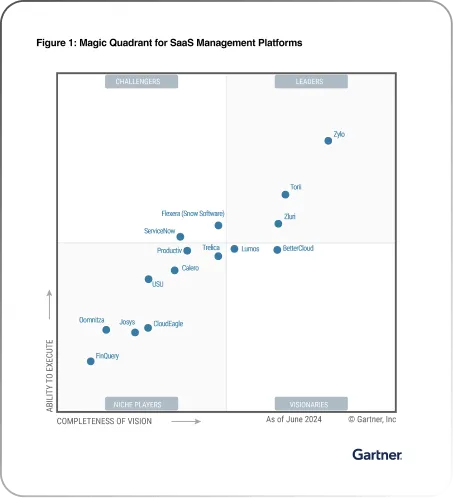SaaS has changed organizations' operations, offering flexibility and scalability like never before. However, with this convenience comes a host of SaaS management challenges. What are these challenges? In this article, we'll explore 5 most common challenges your organization may encounter while managing SaaS apps.
SaaS has become a core component of almost every organization's operations due to its ease of use and simple setup. In fact, it is predicted that, by the end of 2024, 99% of organizations will use at least one SaaS solution.
However, despite the undeniable advantages, organizations also need to be aware of the potential complexities and challenges associated with managing a sprawling SaaS ecosystem. They need to understand that the reality of using and managing SaaS apps is much more complicated. Don't get fooled by its simplistic \"Buy and Go\" approach; it can unknowingly expose companies to risks such as security vulnerabilities, data management issues, and integration challenges with existing systems.
Therefore, before introducing any SaaS solution to your organization, one must first understand the potential SaaS management challenges one may encounter. What are these challenges? How will they impact your organization? Let's find out.
5 Most Common SaaS Management Challenges Faced By Modern Enterprises
Below, we’ve curated a list of SaaS management challenges that organizations commonly encounter:

1: Challenges Associated With Data Security
The data security challenges organizations face can vary depending on factors such as size, the type of industry they're in, the kind of users they have (whether they work remotely or in an office), and the devices they use. However, some common data security challenges can affect any organization's operations. These challenges are often not given enough attention but have the potential to significantly impact data security and operational integrity. What are these challenges?
Here are the 3 major data security challenges your organization may experience while managing SaaS apps.

- Hidden Shadow IT
One of the biggest challenges IT teams face while managing SaaS apps is tracking Shadow IT apps. Shadow IT refers to a situation when employees within the organization start procuring and using SaaS tools on their own without informing the IT team.
But why do employees do that?
This happens because employees sometimes prefer not to follow the formal, lengthy procedure and wait for days to gain access to the company's SaaS tools. Instead, they opt to find and sign up for their own solutions independently to quickly accomplish their tasks, bypassing official IT regulations. As a result, many untracked apps start being used.
Moreover, SaaS is user-friendly and readily accessible, allowing employees to use it without seeking assistance from IT teams (which they often avoid due to long response times).
They can create multiple accounts and use apps without strong security measures like multi-factor authentication (MFA). This makes it hard to manage who can access what, and auditing becomes difficult.
Furthermore, these unapproved apps can pose significant risks as they do not adhere to standard security protocols, exposing critical data to potential data breaches.
- The Larger the SaaS Stack, the Greater the Attack Surface
You need to understand that having more apps will increase your attack surface. This means there are more entry points that hackers can exploit to gain unauthorized access to SaaS apps and data.

This happens because IT teams have limited visibility into how SaaS providers handle and store sensitive data. This lack of transparency makes enforcing strong data security practices difficult, leaving the data vulnerable.
In addition, breaches have become very common and can result from different factors, including software vulnerabilities, human error, and insecure APIs. But when breaches occur, the consequences can be severe, including substantial financial losses, legal penalties, and irreparable damage to the organization’s reputation. This is especially critical when customer data is involved, as regaining trust can be extremely challenging.
- Risks Associated With Abandoned Or Orphaned Applications
Orphaned applications, also known as abandoned apps, present a significant data security challenge. These are apps without any owner, often because an employee who purchased the app for a specific requirement either didn't terminate it properly or left the organization. Without active management or maintenance, these apps become vulnerable as they miss out on essential security updates and patches. This leaves them as potential entry points for cyber threats. Additionally, they may still hold sensitive data or access critical systems, increasing the risk of unauthorized access and data breaches.
2: Spreadsheet Dependence
As you gather data on your SaaS applications, where is it stored? Many organizations use spreadsheets to maintain a master list of all their applications. Individual departments or business units maintain their own records of applications, resulting in no central database, policies, or accountability for managing SaaS inventories.
- For example, a small startup manages its software subscriptions using separate Excel files. The finance team has one spreadsheet listing their tools, while the marketing team maintains another for their apps.
So, there's no single source of truth (centralized system) for tracking all software across the company. This creates confusion regarding which licenses are active, which unused subscriptions you are overspending, and whether the apps comply with regulations.
Furthermore, when it's time for budget reviews or audits, compiling accurate data from scattered spreadsheets becomes a headache. This completely slows down important decision-making processes.
Even if you use a centralized spreadsheet, there are significant drawbacks:
- It's easy to accidentally enter incorrect information or delete data.
- There are minimal controls over who can access the data.
- While filters and formulas can assist with analysis, they have limitations.
- The information in the spreadsheet cannot be automated.
3: SaaS App Optimization Issue
Organizations may face difficulty in optimizing SaaS apps for two main reasons:

- Presence Of Duplicate Applications In Existing SaaS Stack
Since individual users and departments can easily adopt SaaS applications, it's common to end up with duplicate or multiple applications that do the same thing. These duplications complicate your tech stack. For example, a department might buy a team license for a specific project and then forget to switch back to an individual license when the project ends.
So, if you don't know what software you have, it can be extremely challenging to figure out what to eliminate. This will further increase your SaaS expenses, draining your overall budget.
- Promotion Of Auto-Renewals
Auto-renewals can be a big challenge during SaaS optimization. When subscriptions automatically renew without undergoing a thorough assessment of their necessity and value, it becomes difficult to forecast and control expenses effectively. This lack of evaluation can result in organizations paying for SaaS app subscriptions that may no longer be essential or cost-effective.
Furthermore, auto-renewals also complicate efforts to streamline the SaaS stack. They can lead to a cluttered software stack with unused licenses and redundant software, increasing costs and hampering operational efficiency.
- Getting Caught In Vendor Lock-Ins
\"Vendor lock-ins\" refer to situations where an organization becomes heavily dependent on a particular software vendor due to various factors such as integration, customization, or reliance on specific features. This dependency limits the organization's flexibility to switch to alternative applications or vendors based on changing internal needs or external factors. It can lead to challenges such as being stuck with outdated technology, facing high switching costs, or being unable to adapt to evolving business requirements.
4: Compliance Challenges
Organizations can encounter numerous compliance challenges while managing SaaS applications. However, below, we’ve discussed two of the most significant compliance issues that you may come across:

- Multi-Regional Compliance Challenge
SaaS apps present compliance challenges, often due to data being stored in various geographic locations and the type of data being handled, such as — healthcare info belonging to citizens of specific regions. Depending on these factors, organizations need to comply with regulations like GDPR in the European Union, HIPAA in the United States, and CCPA in California. Each regulation has strict requirements and severe penalties for non-compliance/ compliance violations, making it essential to adhere to all.
However, complying with multiple regulations requires extensive resources and a strategic approach to consistently meet all regional and sector-specific legal standards. For instance, IT teams need to maintain detailed records of all data handling and processing activities, including precise logs of who accessed the data and when to meet stringent regulations.
- Compliance Challenge Associated With Vendors
The threat of compliance from a third-party vendor (a SaaS app used at your company) is very real—from unauthorized usage and weak audit trails to archaic information security protocols. Given the rise of data sharing among SaaS apps, you need to increase your awareness levels to take a zero-compromise stance on ensuring compliance.
Two of the largest attacks in the last decade had taken place through third-party vendors:
- A vendor breach cost Equifax (a credit monitoring company) $1.38 billion in 2017.
- The hackers exploited a vulnerability in Apache Struts, an open-source tool for building web applications. The result was the sensitive data leakage (name, SSN, DOB, address, driving license, and credit card numbers) of approximately 147 million consumers.
- A vendor breach in 2013 cost Target $236 million in total expenses and 140 lawsuits were filed against the company. According to a state investigation, “the cyber attacker managed to access Target’s computer gateway by stealing credentials from a third-party HVAC vendor.” These credentials helped the hackers exploit weaknesses in the company’s system, enter the customer service database, and install malware. The attackers accessed sensitive data such as full names, emails, credit card numbers, verification codes, etc.
5: Integration Hurdles That Slow You Down
Many SaaS apps are designed to work on their own but can also connect with a company's existing technology. If these apps aren't integrated properly, it can lead to data silos, where information is separated by departments. This makes sharing data between systems and teams difficult, slowing down operations and decision-making.
A lack of integration also complicates user access management. Using existing authentication systems like LDAP or Active Directory (AD) makes it easier to control who has access. Each SaaS environment must be managed separately without this integration, increasing operational friction and security risks. For example, if a user leaves the organization, their access may not be updated in every SaaS application, posing a security threat.
Now that you are familiar with the common SaaS management challenges, you will probably need an effective solution to address them as well. So, this is where SaaS management platforms like Zluri come into play. What Is Zluri? How Does It Work? Let's find out.
Seamlessly Tackle Your SaaS Management Challenges With An Effective SMP
Zluri offers an intelligent SaaS management solution with a wide range of features designed to help your team discover, manage, optimize, and secure SaaS applications. Below, we’ve explained each feature of Zluri’s SMP in detail so you can better understand how it works.
- Application Discovery: Zluri’s SMP uses 9 different discovery methods to identify all the SaaS apps present within an organization's SaaS stack.

Zluri’s nine discovery methods
These methods discover all the apps and provide insights into app types (approved or not), app owners, who are using those apps, risk scores, compliance data, and more.
With this level of insight, IT teams can easily track and address unauthorized or unapproved apps, thereby minimizing the occurrence of shadow IT. This visibility also enables IT teams to effectively manage all SaaS applications, optimizing their usage, enhancing security, ensuring compliance, and improving overall operational efficiency.
- License Management: Zluri's SMP consolidates all your SaaS app licenses into a centralized dashboard, offering a complete view of your software inventory in a single location.
Also, as per Kuppingercole's research and analysis report, Zluri's SMP not only organizes all licenses but also provides insights into application usage, such as — active usage statistics, identification of underutilized applications, user counts per application, and additional relevant data points.
This way, you can make informed decisions regarding which licenses to remove, reclaim, and reallot, thereby effectively mitigating SaaS management challenges like (SaaS app optimization).
- Renewal Calendar: Zluri’s SMP offers a renewal calendar that shows all the upcoming renewals and payments in one place.
By default, you will receive alerts for contracts 30, 15, 7, and 1 day before renewal and for payments 7 and 1 day before renewal (these alerts can be customized as well). This ensures you never miss an upcoming renewal and that all the services are always up and running.

Zluri’s renewal calendar
- Optimization Summary: Zluri's optimization summary feature goes beyond mere snapshots, offering deep insights into spend optimization and potential cost savings. It utilizes historical user usage data to uncover valuable insights for your team. Furthermore, this helps mitigate SaaS management challenges associated with optimizing SaaS stack.

Zluri’s optimization summary dashboard
- Vendor Management: Zluri's SMP is a single source of truth for vendor contracts. With the help of this SaaS vendor management feature, you can identify the number of contracts signed with them, how many contracts are active, and how many have expired.With Zluri's SMP, all contracts are stored with other vendors' data so that you, as a manager, can access them when required, for instance, during renewals, terminations, and audits. Also, having all contract data readily available streamlines these processes and ensures that you can efficiently manage and monitor vendor relationships. Additionally, maintaining up-to-date contract data is important for compliance purposes. It helps you adhere to regulatory requirements and avoid SaaS management challenges like non-compliance risks.To learn more about Zluri's SaaS management platform, Book a Demo now.
Overcome SaaS Management Challenges To Ensure Smooth Business Operations
In conclusion, while SaaS offers convenience and widespread adoption in modern business operations, it also introduces significant challenges. These include managing data security risks, handling unauthorized software use, navigating complex integrations, ensuring regulatory compliance, and optimizing costs. However, these SaaS management challenges can be mitigated by leveraging comprehensive SaaS management platforms like Zluri. Such tools provide essential capabilities to organize, secure, and optimize SaaS apps, enabling businesses to ensure smooth operations.
Frequently Asked Questions (FAQs)
What security measures should IT Teams implement to protect data in SaaS applications?
IT teams need to do the following to protect SaaS app data:
- Enforce strong authentication methods
- Encrypt sensitive data both in transit and at rest
- Implement access controls based on the least privilege
- Conduct regular security audits
- Ensure compliance with relevant data protection regulations
How can organizations optimize their SaaS usage and costs?
IT teams can implement the following optimization strategies:
- Conducting regular audits of SaaS subscriptions
- Identifying and eliminating unused or redundant applications
- Negotiating favorable terms with vendors
- Implementing policies to manage user access and license utilization
What are orphaned apps?
An orphaned application, also known as an abandoned application, refers to an application installed within an organization but no longer actively maintained or used. This typically occurs when the employee who initiated the application leaves the organization or when the application is purchased for a specific project that has since been completed or discontinued.









.svg)





























.webp)







.webp)
.webp)





.webp)